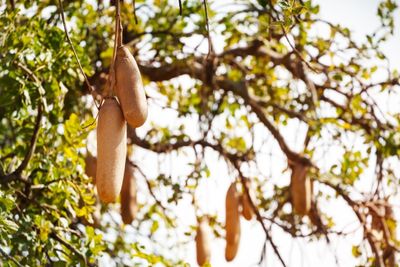What is a Sausage Tree?
Kigelia is found from Eritrea and Chad south to northern South Africa and west to Senegal and Namibia. It is a tree that can grow up to 66 feet (20 m.) in height with smooth, gray bark on juvenile trees that peels as the tree matures. In areas of plentiful rainfall, the Kigelia is an evergreen. In areas of scant rain, sausage trees are deciduous. The leaves are set in whorls of three, 12 to 20 inches (31-50 cm.) in length and 2 ¼ inches (6 cm.) wide.
Sausage Tree Info
The most interesting thing about growing Kigelia sausage trees are the blossoms and resulting fruit. The blood-red flowers bloom at night on long, ropy stalks that dangle from the limbs of the tree. They release an unpleasant aroma that bats find very appealing. This odor draws in the bats, insects, and other birds to feed on the nectar rich blooms which are in turn pollinated by the animals. The fruit, actually a berry, droops down from the long stalks. Each mature fruit may grow up to 2 feet long (61 cm.) and weigh up to 15 pounds (7 kg.)! The common tree for Kigelia comes from the look of the fruit; some say they look like large sausages dangling from the tree. The fruit is fibrous and pulpy with many seeds and is toxic to humans. Many types of animals enjoy the fruit including baboons, bushpigs, elephants, giraffes, hippos, monkeys, porcupines, and parrots. Humans also ingest the fruit, but it must be specially prepared either by drying, roasting, or most commonly fermenting into an alcoholic beverage somewhat like beer. Some native people chew the bark to treat stomach ailments. The Akamba people mix the juice of the fruit with sugar and water to treat typhoid. The wood of the sausage tree is soft and burns quickly. The shade of the tree is also often the site for ceremonies and leadership meetings. For both reasons, it is seldom cut for wood or fuel.
How to Grow Kigelia Trees
In some tropical regions, this tree is grown as an ornamental for its lovely glossy dark green foliage, erect to spreading low canopy, and fantastic flowers and fruit. It can be grown in sunset zones 16 to 24 in well-draining sun composed of clay, loam, or sand and in full sun. Soil should have a pH that is slightly acidic to neutral. Once the tree has established, it requires little additional sausage tree care and can potentially delight and amaze generations, as it can live from 50 up to 150 years of age.
